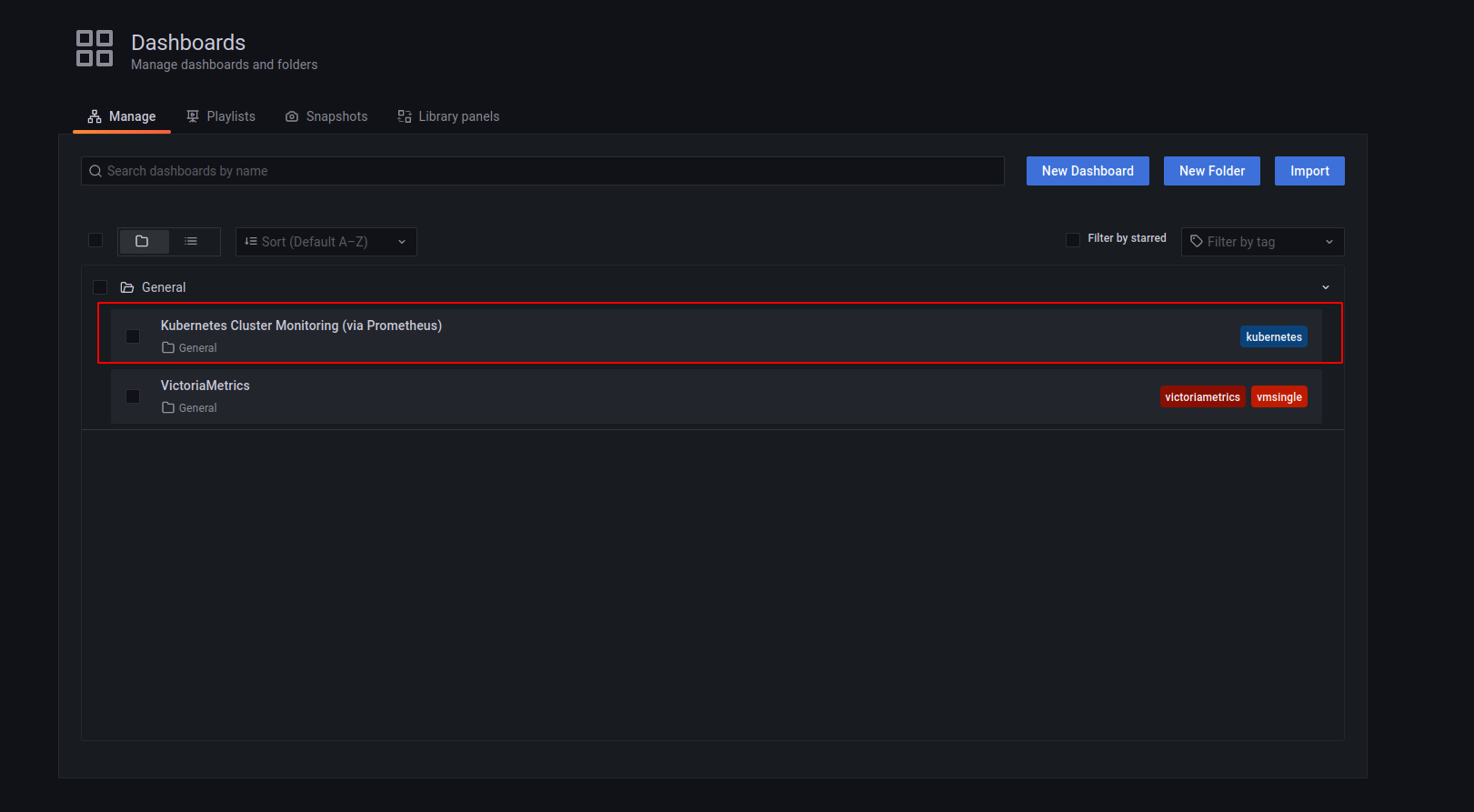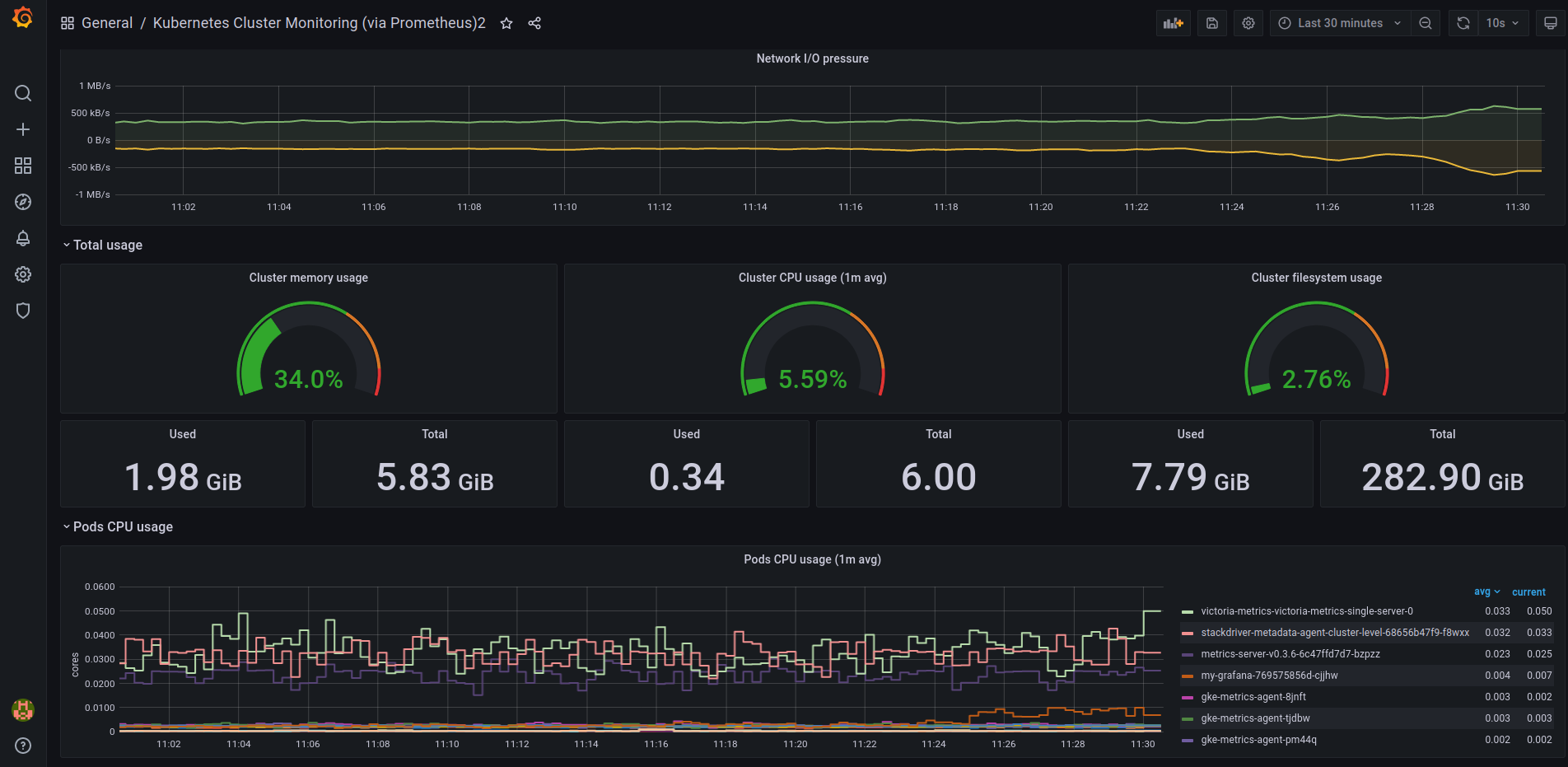# Kubernetes monitoring with VictoriaMetrics Single
**This guide covers:**
* The setup of VictoriaMetrics single node in Kubernetes via helm charts
* How to store metrics
* How to scrape metrics from k8s components using service discovery
* How to Visualize stored data
**Precondition**
We will use:
* [Kubernetes cluster 1.19.10-gke.1600](https://cloud.google.com/kubernetes-engine)
> We use GKE cluster from GCP but feel free to use any kubernetes setup eg [Amazon EKS](https://aws.amazon.com/ru/eks/)
* [helm 3 ](https://helm.sh/docs/intro/install)
* [kubectl 1.21](https://kubernetes.io/docs/tasks/tools/install-kubectl)

**1. VictoriaMetrics helm repository**
> For this guide we will use helm 3 but if you already use helm 2 please see this [https://github.com/VictoriaMetrics/helm-charts#for-helm-v2](https://github.com/VictoriaMetrics/helm-charts#for-helm-v2)
You need to add the VictoriaMetrics helm repository to install VictoriaMetrics components. We’re going to use VictoriaMetrics single-node. You can do this by running the following command:
```bash
helm repo add vm https://victoriametrics.github.io/helm-charts/
```
Update helm repositories:
```bash
helm repo update
```
To verify that everything is set up correctly you may run this command:
```bash
helm search repo vm/
```
The expected output is:
```bash
NAME CHART VERSION APP VERSION DESCRIPTION
vm/victoria-metrics-agent 0.7.20 v1.62.0 Victoria Metrics Agent - collects metrics from ...
vm/victoria-metrics-alert 0.3.34 v1.62.0 Victoria Metrics Alert - executes a list of giv...
vm/victoria-metrics-auth 0.2.23 1.62.0 Victoria Metrics Auth - is a simple auth proxy ...
vm/victoria-metrics-cluster 0.8.30 1.62.0 Victoria Metrics Cluster version - high-perform...
vm/victoria-metrics-k8s-stack 0.2.8 1.16.0 Kubernetes monitoring on VictoriaMetrics stack....
vm/victoria-metrics-operator 0.1.15 0.15.1 Victoria Metrics Operator
vm/victoria-metrics-single 0.7.4 1.62.0 Victoria Metrics Single version - high-performa...
```
**2. Install VictoriaMetrics Single from helm Chart**
Run this command in your terminal:
```yaml
cat <
* By running `helm install victoria-metrics vm/victoria-metrics-single` we will install `VictoriaMetrics Single` to default namespace inside your cluster
* By adding `scrape: enable: true` we add and enable autodiscovery scraping from kubernetes cluster to `VictoriaMetrics Single`
As a result of the command you will see the following output:
```bash
NAME: victoria-metrics
LAST DEPLOYED: Fri Jun 25 12:06:13 2021
NAMESPACE: default
STATUS: deployed
REVISION: 1
TEST SUITE: None
NOTES:
The VictoriaMetrics write api can be accessed via port 8428 on the following DNS name from within your cluster:
victoria-metrics-victoria-metrics-single-server.default.svc.cluster.local
Metrics Ingestion:
Get the Victoria Metrics service URL by running these commands in the same shell:
export POD_NAME=$(kubectl get pods --namespace default -l "app=server" -o jsonpath="{.items[0].metadata.name}")
kubectl --namespace default port-forward $POD_NAME 8428
Write url inside the kubernetes cluster:
http://victoria-metrics-victoria-metrics-single-server.default.svc.cluster.local:8428/api/v1/write
Metrics Scrape:
Pull-based scrapes are enabled
Scrape config can be displayed by running this command:
kubectl get cm victoria-metrics-victoria-metrics-single-server-scrapeconfig -n default
The target’s information is accessible via api:
Inside cluster:
http://victoria-metrics-victoria-metrics-single-server.default.svc.cluster.local:8428/atargets
Outside cluster:
You need to port-forward service (see instructions above) and call
http:///targets
Read Data:
The following url can be used as the datasource url in Grafana:
http://victoria-metrics-victoria-metrics-single-server.default.svc.cluster.local:8428
```
For us it’s important to remember the url for the datasource (copy lines from output).
Verify that VictoriaMetrics pod is up and running by executing the following command:
```bash
kubectl get pods
```
The expected output is:
```bash
NAME READY STATUS RESTARTS AGE
victoria-metrics-victoria-metrics-single-server-0 1/1 Running 0 22s
```
**3. Install and connect Grafana to VictoriaMetrics with helm**
Add the Grafana helm repository.
```bash
helm repo add grafana https://grafana.github.io/helm-charts
helm repo update
```
See more info on Grafana ArtifactHUB [https://artifacthub.io/packages/helm/grafana/grafana](https://artifacthub.io/packages/helm/grafana/grafana)
By installing the Chart with the release name `my-grafana`, you add the VictoriaMetrics datasource with official dashboard and kubernetes dashboard:
```yaml
cat <
By running this command we:
* Install Grafana from helm repository.
* Provision VictoriaMetrics datasource with the url from the output above which we copied before.
* Add this [https://grafana.com/grafana/dashboards/10229](https://grafana.com/grafana/dashboards/10229) dashboard for VictoriaMetrics.
* Add this [https://grafana.com/grafana/dashboards/14205](https://grafana.com/grafana/dashboards/14205) dashboard to see Kubernetes cluster metrics.
Check the output log in your terminal.
To see the password for Grafana `admin` user use the following command:
```bash
kubectl get secret --namespace default my-grafana -o jsonpath="{.data.admin-password}" | base64 --decode ; echo
```
Expose Grafana service on `127.0.0.1:3000`:
```bash
export POD_NAME=$(kubectl get pods --namespace default -l "app.kubernetes.io/name=grafana,app.kubernetes.io/instance=my-grafana" -o jsonpath="{.items[0].metadata.name}")
kubectl --namespace default port-forward $POD_NAME 3000
```
Now Grafana should be accessible on the [http://127.0.0.1:3000](http://127.0.0.1:3000) address.
**4. Check the obtained result in your browser**
To check that VictoriaMetrics has collected metrics from the k8s cluster open in browser [http://127.0.0.1:3000/dashboards](http://127.0.0.1:3000/dashboards) and choose `Kubernetes Cluster Monitoring (via Prometheus)` dashboard. Use `admin` for login and `password` that you previously obtained from kubectl.

You will see something like this:

VictoriaMetrics dashboard also available to use:

**5. Final thoughts**
* We have set up TimeSeries Database for your k8s cluster.
* We collected metrics from all running pods, nodes, … and stored them in VictoriaMetrics database.
* We can visualize the resources used in your Kubernetes cluster by using Grafana dashboards.




